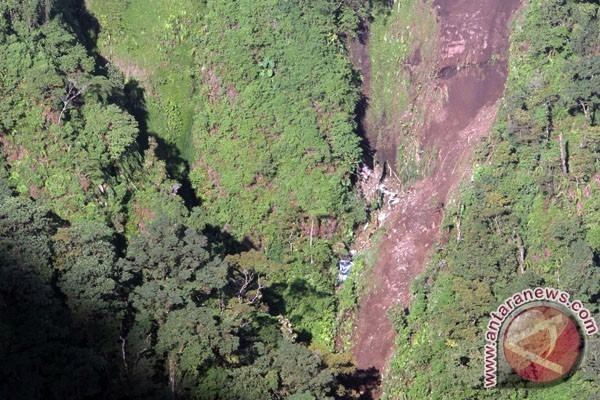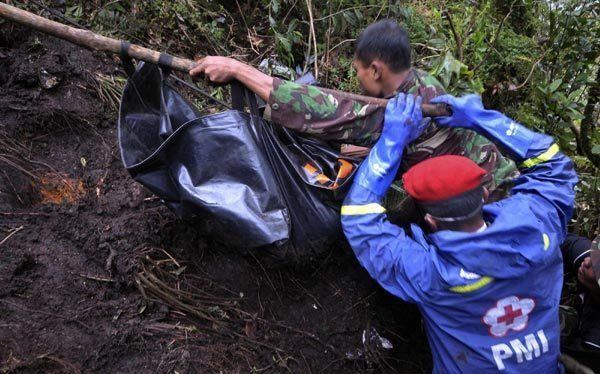Site Mount Salak, Indonesia Survivors 0 Registration 97004 Operator Sukhoi Survivor 0 Crew count 8 | Passengers 37 Aircraft type Sukhoi SSJ-100-95 Date 9 May 2012 Fatalities 45 (all) Passenger count 37 | |
 | ||
Summary Controlled flight into terrain
Human factor
Impacted mountainside during demonstration flight
Pilot error Similar Garuda Indonesia Flight 152, UTair Flight 120, Bhoja Air Flight 213, Adam Air Flight 574, Dana Air Flight 992 | ||
The Mount Salak Sukhoi Superjet 100 (SSJ-100) crash occurred on 9 May 2012 when an SSJ-100 aircraft crashed on a demonstration flight operating from Halim Perdanakusuma Airport, Jakarta, Indonesia. On 10 May, the wreckage of the Sukhoi Superjet was spotted on a cliff in Mount Salak, a volcano in the province of West Java. Due to the widespread debris field where the aircraft hit the mountain, rescuers concluded that the aircraft directly impacted the rocky side of the mountain and that there was "no chance of survival". On 12 May 2012, it was reported that the remains of several victims' bodies had been recovered and airlifted to Halim Airport and then taken to the National Police Hospital for identification.
Contents

The final report, released 18 December 2012, indicated that the accident was caused by crew members ignoring terrain warnings that they had incorrectly attributed to a database problem. The crew had turned off the terrain warning system and were unaware that they were operating in close proximity to mountains. The crew, including the captain, were engaging in conversation with potential customers as the aircraft impacted the ground.
Aircraft

The aircraft involved in the accident was a Sukhoi SSJ-100-95, registration 97004, msn 95004. The aircraft was manufactured in 2009 and had accumulated over 800 flight hours at the time of the accident. The Superjet 100 is the first production airliner model produced in Russia since the dissolution of the USSR in 1991.
Demonstration tour

The jet was flying as part of a "Welcome Asia!" demonstration tour when the crash happened. With a different jet, a demo flight had been flown successfully in Kazakhstan, but when the tour moved to Pakistan, potential buyers could see the aircraft only on the runway as no flight took place, reportedly due to a technical glitch. A leak in a 'nozzle in the engine' was found in this plane on the way to Myanmar, according to Alexander Tulyakov, vice-president of the United Aircraft Corporation, and it returned to Moscow. The jet involved in the accident was then flown in as a replacement to continue the tour. It had been scheduled to visit Laos and Vietnam. At the time of the crash, Sukhoi had 42 orders of the type from Indonesia, 170 in total, and was hoping to produce up to 1,000 aircraft.
Mount Salak
In the decade between 2002 and 2012, there were seven aviation crashes in the area of Mount Salak. Three people were killed in a crash of a training aircraft not long before the SSJ-100 accident; 18 people were killed in a crash of an Indonesian Air Force military aircraft in 2008; five people were killed in a small crash in June 2004, two in April 2004, seven in October 2003, and one in October 2002.
The Jakarta Post has dubbed Mount Salak "an airplane graveyard". High turbulence and fast-changing weather conditions of the mountainous terrain are cited as contributing factors to multiple aviation crashes in the area.
Crash
At 14:00 local time (07:00 UTC), the SSJ-100 departed from Halim Perdanakusuma Airport for a local demonstration flight, and was due to return to the departure point. This was the second demonstration flight the aircraft was operating that day. There were six crew, two representatives from Sukhoi and 37 passengers on board. Amongst the passengers were representatives from Aviastar Mandiri, Batavia Air, Pelita Air Service and Sriwijaya Air. At 14:21 (07:21 UTC), the crew requested permission to descend from 10,000 feet (3,000 m) to 6,000 feet (1,800 m) for reasons which were unclear, and this was granted. This was the last contact that Air Traffic Control had with the aircraft, which was then about 75 nautical miles (139 km) south of Jakarta, in the vicinity of 7,254-foot (2,211 m) high Mount Salak, a mountain higher than the requested flight level.
Simon Hradecky, of The Aviation Herald, later reported:
"Indonesia's Air Traffic Control, Jakarta Branch, reported that communication between ATC and aircraft was done in English, there was no language problem hampering communication. The aircraft had been in the area of Bogor, approximate coordinates 6.55°S 106.9°E / -6.55; 106.9, about 13 nautical miles (24 km) northeast of the peak of Mount Salak and 7 nautical miles (13 km) clear of mountainous terrain in safe flat area, when the crew requested to descend and to perform a right orbit. As there was no reason to decline such a clearance the flight was cleared down and for the right orbit. This was the last transmission from the aircraft, the aircraft could not be reached afterwards. The plane having finished right orbit flew a course about 210°. It is unclear how the aircraft got into the area of Mount Salak and crashed afterwards, ATC services hope the black boxes will explain how the aircraft got there. All data including flight plan, radar data and ATC recordings as well as transcripts of interviews with the air traffic controller have been handed to Indonesia's NTSC."
In December 2012, the crash investigation determined that the plane's terrain warning system had been functioning correctly and had warned the pilots about the collision course with the mountain. The pilots, however, turned the system off, suspecting it to have malfunctioned. Due to being distracted by conversation on the flight deck, unrelated to flying the plane, they failed to notice that the plane was in danger.
A ground and air search for the aircraft was initiated, but was called off as night fell. On 10 May at 09:00 (02:00 UTC), the wreckage of the Sukhoi Superjet was found on Mount Salak. It is only known that the aircraft had been flying on a clockwise flightpath around the mountain, towards Jakarta, before the crash. Preliminary reports indicated that the aircraft had hit the edge of a cliff at an elevation of 6,270 feet (1,910 m), slid down a slope and came to rest at an elevation of 5,200 feet (1,600 m). Despite appearing relatively intact from the air, the aircraft sustained substantial damage, and there was no sign of survivors. The site of the accident was not accessible by air and no rescuers had reached the site by nightfall on 10 May. Multiple groups of rescue personnel attempted to reach the wreckage on foot.
Victims
Most of the passengers were journalists and prospective clients. The 45 people on board included 14 people from the Indonesian airline Sky Aviation, Captain Aan Husdiana (Director of Operations for Kartika Airlines) and five reporters, Dody Aviantara (journalist) and Didik Nur Yusuf (photographer) from Angkasa aviation magazine, Ismiati Soenarto and Aditya Sukardi of Trans TV and Femi Adi of the American Bloomberg News. An accomplished and experienced pilot, Peter Adler held a US passport, acting as a consultant and a passenger on the flight; according to Vladimir Prisyazhnyuk, the head of Sukhoi Civil Aircraft, two Italians and one French citizen of Vietnamese descent were also on board. The captain of the jet was Alexander Yablontsev, a former Russian test pilot; he had been the pilot for the first test flight of Superjet 100 in May 2008. The first officer was Alexander Kotchetkov.
Investigation
The day after the crash Russian Prime Minister Dmitry Medvedev set up a commission, to investigate the cause of the accident, headed by the Industry and Trade Ministry's Yury Slyusar. According to the National Transportation Safety Committee (NTSC), the Indonesian agency for the investigation of civil aircraft accidents, analysis of the crash would take up to 12 months. On 15 May 2012, it was reported in the local media that the Indonesian government had turned down Russia's request to send back the flight data recorder, stating that Indonesian investigators would determine the cause of the crash, while Russian experts would provide support only. The cockpit voice recorder was found on 15 May 2012 at a distance of 200 m from the tail section. The flight data recorder was found on 31 May 2012 at a distance of 200 m from the tail section.
The Indonesian NTSC had released their Preliminary Report, which listed factual findings but did not attempt to determine the cause of the accident.
According to sources within the investigating committee, the aircraft was in full working order and the incident was ascribed to human error.
The final report was released 18 December 2012 and indicated that the accident was caused by crew members ignoring terrain warnings that they had incorrectly attributed to a database problem. The crew had turned off the terrain warning system and were unaware that they were operating in close proximity to mountains. The crew, including the captain, were engaging in conversation with potential customers as the aircraft impacted the ground.
Aftermath
Sky Aviation, an Indonesian air carrier, delayed the delivery of 12 Superjet 100s following the accident. Arifin Seman, the commissioner of Kartika Airlines, another domestic Indonesian carrier, went on record to say that the delivery of 30 Superjet 100s, which his company had ordered, would likely be delayed following the crash. Several days later, however, the same source published Sky Aviation's statement in which they declared that they were not going to cancel the contract. Moreover, Sky Aviation's general manager for promotion, Sutito Zainuddin, added that "the additional 100-seat planes would be needed to connect major cities in Indonesia, particularly Jakarta". Mexico's Interjet Board chairman Miguel Alemаn Velasco said the crash had no influence on the company's desire to purchase additional Superjets.
The Russian airline Aeroflot and Armenian Armavia, the two operators of the SSJ-100 at the time of the crash, had not suspended operations of the type. Armavia said that it would continue negotiations over the purchase of another Superjet 100 for its fleet.
